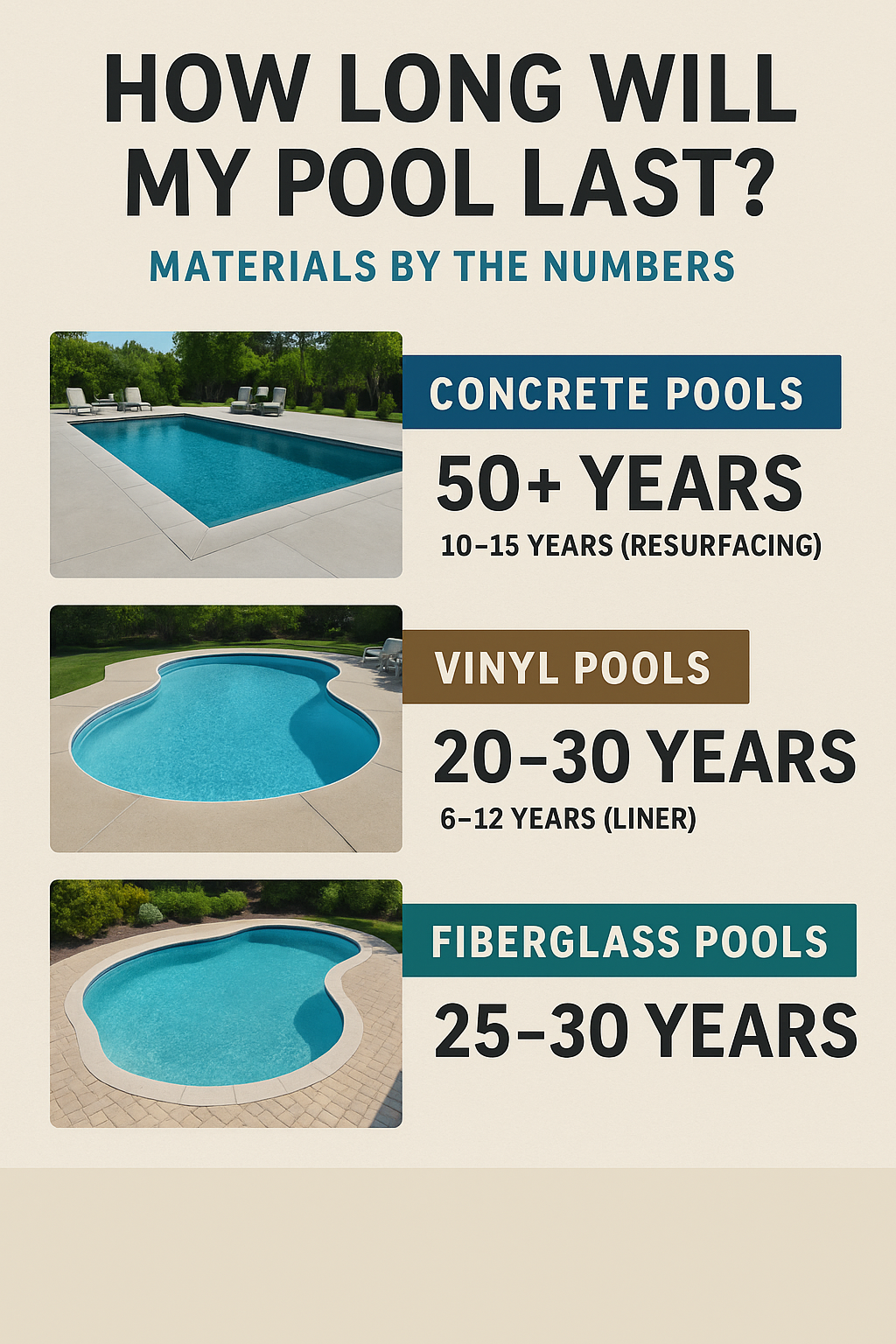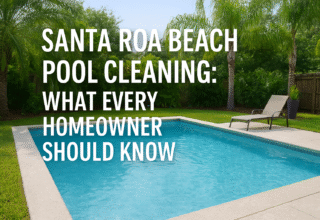Installing a pool is a major investment. Whether you’re planning a new build or inheriting an older pool, the question comes up often: How long will it last? The answer depends on materials, maintenance, usage, and local climate. But materials matter most. Understanding the lifespan of each component can help you budget for repairs, upgrades, or a full renovation.
Here’s how the most common pool types stack up by the numbers.
Concrete Pools: Durable, But High-Maintenance
Lifespan: 50+ years (structure), 10–15 years (resurfacing)
Concrete or gunite pools are the most durable structurally. The shell can last for decades, especially if properly built and maintained. But the surface finish, usually plaster or aggregate, has a much shorter life. Expect to resurface every 10 to 15 years depending on water chemistry, usage, and climate.
Pros:
- Highly customizable shapes and finishes
- Extremely strong
- Long lifespan with structural integrity
Cons:
- Requires periodic resurfacing
- Higher maintenance
- Rougher surface may require more frequent cleaning
Vinyl Pools: Cost-Effective, Shorter Lifespan
Lifespan: 20–30 years (structure), 6–12 years (liner)
Vinyl liner pools offer an affordable entry point. While the supporting structure can last up to three decades, the liner is the weakest link. Liners typically last 6 to 12 years depending on sun exposure, water chemistry, and sharp objects.
Pros:
- Lower initial cost
- Smooth surface
- Easier installation
Cons:
- Liners are vulnerable to tears and fading
- Less durable over time
- Limited design flexibility
Fiberglass Pools: Low Maintenance, Mid-Range Lifesp
Lifespan: 25–30 years
Fiberglass pools come pre-molded and offer excellent durability with minimal upkeep. The gelcoat finish resists algae and staining, and maintenance is much simpler compared to concrete. With proper care, a fiberglass shell can last over 25 years without needing resurfacing.
Pros:
- Lowest maintenance needs
- Smooth, non-porous surface
- Fast installation
Cons:
- Limited shape and size options
- Can be damaged during transport or installation
- Repairs are visible if not matched perfectly
Tile and Aggregate Finishes: Aesthetic Boost, Variable Lifespans
Tile: 15–25 years
Pebble or quartz aggregate: 10–20 years
Premium finishes like tile or aggregate can extend the aesthetic life of your pool, but not the structural shell. Tiles are long-lasting if installed correctly, while exposed aggregate adds texture and traction with a modern look. However, both can degrade faster in hard water environments.
Essential Pool Components and Their Lifespan
Beyond the shell and surface, your pool includes multiple systems that influence long-term costs and usability.
Pool Pump: 8–12 years
Filter: 5–10 years
Heater: 7–15 years (gas), 10–20 years (electric)
Salt Cell (for saltwater pools): 3–7 years
Lighting: 5–15 years depending on type (LEDs last longer)
Partnering with a trusted provider like Vista Pools LLC ensures professional installation, proper equipment selection, and routine maintenance, all critical for maximizing longevity.
How to Extend the Life of Your Pool
No matter the material, smart maintenance makes a difference. Here are six ways to preserve your investment:
- Maintain water chemistry: Imbalanced pH and chlorine levels accelerate surface degradation.
- Clean regularly: Prevent buildup of debris and algae.
- Inspect equipment: Catch leaks or inefficiencies before they cause damage.
- Cover your pool: Reduces UV exposure and prevents debris accumulation.
- Schedule professional inspections: Services like pool service Henderson can spot issues before they become costly.
- Avoid sharp objects: Especially important with vinyl liners.
FAQs
How do I know when my pool needs resurfacing?
Look for stains, rough texture, or chalky residue. Peeling or etching on the surface is also a clear sign. Professional inspections can help confirm.
Is it worth upgrading from vinyl to fiberglass or concrete?
That depends on your long-term goals. If you’re staying in the home for 10+ years and want a more durable, lower-maintenance pool, it may be worth the investment.
Can I repair a fiberglass pool myself?
Minor surface scratches can sometimes be buffed out. But structural cracks or gelcoat damage should be handled by professionals to ensure proper bonding and color match.











